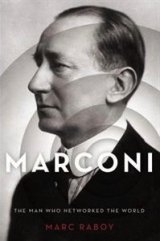 Marconi: The Man Who Networked the World
Marconi: The Man Who Networked the World
Marc Raboy
Raboy, Marc. Marconi: The Man Who Networked the World. Oxford University Press, 2016.
As Marc Raboy shows us in this enthralling and comprehensive biography, Marconi was the first truly global figure in modern communications. Born to an Italian father and an Irish mother, he was in many ways stateless, working his cosmopolitanism to advantage. Through a combination of skill, tenacity, luck, vision, and timing, Marconi popularized-and, more critically, patented-the use of radio waves. Soon after he burst into public view with a demonstration of his wireless apparatus in London at the age of 22 in 1896, he established his Wireless Telegraph & Signal Company and seemed unstoppable. He was decorated by the Czar of Russia, named an Italian Senator, knighted by King George V of England, and awarded the Nobel Prize for Physics-all before the age of 40. Until his death in 1937, Marconi was at the heart of every major innovation in electronic communication, courted by powerful scientific, political, and financial interests, and trailed by the media, which recorded and published nearly every one of his utterances. He established stations and transmitters in every corner of the globe, from Newfoundland to Buenos Aires, Hawaii to Saint Petersburg.
Based on original research and unpublished archival materials in four countries and several languages, Raboy's book is the first to connect significant parts of Marconi's story, from his early days in Italy, to his groundbreaking experiments, to his protean role in world affairs. Raboy also explores Marconi's relationships with his wives, mistresses, and children, and examines in unsparing detail the last ten years of the inventor's life, when he returned to Italy and became a pillar of Benito Mussolini's fascist regime. Raboy's engrossing biography, which will stand as the authoritative work of its subject, proves that we still live in the world Marconi created.
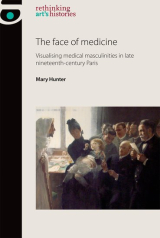 The face of medicine: Visualising medical masculinities in late nineteenth-century Paris
The face of medicine: Visualising medical masculinities in late nineteenth-century Paris
Mary Hunter
Hunter, Mary. The face of medicine: Visualising medical masculinities in late nineteenth-century Paris. Manchester University Press, 2015.
The face of medicine examines the overlapping worlds of art and medicine in late nineteenth-century France. It sheds new light on the relevance of the visual in medical and scientific cultures, and on the relationship between artistic and medical practices and imagery. By examining previously unstudied sources that traverse disciplinary boundaries, this original study rethinks the politics of medical representations and their social impact. Through a focused examination of paintings from the 1886 and 1887 Paris Salons that portray famous men from the medical and scientific elite - Louis Pasteur, Jules-Émile Péan and Jean-Martin Charcot - along with the images and objects that these men made for personal and occupational purposes, Hunter argues that artworks and medical collections played a key role in forming the public face of scientific medicine.
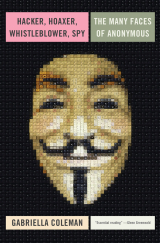
Hacker, Hoaxer, Whistleblower, Spy: The Many Faces of Anonymous
Coleman, Gabriella. Hacker, Hoaxer, Whistleblower, Spy: The Many Faces of Anonymous. Verso, 2014.
Here is the ultimate book on the worldwide movement of hackers, pranksters, and activists that operates under the non-name Anonymous, by the writer the Huffington Post says “knows all of Anonymous’ deepest, darkest secrets.” Half a dozen years ago, anthropologist Gabriella Coleman set out to study the rise of this global phenomenon just as some of its members were turning to political protest and dangerous disruption (before Anonymous shot to fame as a key player in the battles over WikiLeaks, the Arab Spring, and Occupy Wall Street). She ended up becoming so closely connected to Anonymous that the tricky story of her inside-outside status as Anon confidante, interpreter, and erstwhile mouthpiece forms one of the themes of this witty and entirely engrossing book. The narrative brims with details unearthed from within a notoriously mysterious subculture, whose semi-legendary tricksters – such as Topiary, tflow, Anachaos, and Sabu – emerge as complex, diverse, politically and culturally sophisticated people. Propelled by years of chats and encounters with a multitude of hackers, including imprisoned activist Jeremy Hammond and the double agent who helped put him away, Hector Monsegur, Hacker, Hoaxer, Whistleblower, Spy is filled with insights into the meaning of digital activism and little understood facets of culture in the Internet age, including the history of “trolling,” the ethics and metaphysics of hacking, and the origins and manifold meanings of “the lulz.”
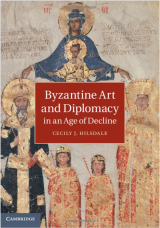
Byzantine Art and Diplomacy in an Age of Decline
Cecily Hilsdale
Hilsdale, Cecily. Byzantine Art and Diplomacy in an Age of Decline. Cambridge University Press, 2014.
The Late Byzantine period (1261–1453) is marked by a paradoxical discrepancy between economic weakness and cultural strength. The apparent enigma can be resolved by recognizing that later Byzantine diplomatic strategies, despite or because of diminishing political advantage, relied on an increasingly desirable cultural and artistic heritage. This book reassesses the role of the visual arts in this era by examining the imperial image and the gift as reconceived in the final two centuries of the Byzantine Empire. In particular it traces a series of luxury objects created specifically for diplomatic exchange with such courts as Genoa, Paris and Moscow alongside key examples of imperial imagery and ritual. By questioning how political decline refigured the visual culture of empire, Dr Hilsdale offers a more nuanced and dynamic account of medieval cultural exchange that considers the temporal dimensions of power and the changing fates of empires.

Wicked Intelligence: Visual Art and the Science of Experiment in Restoration London
Matthew Hunter
Hunter, Matthew. Wicked Intelligence: Visual Art and the Science of Experiment in Restoration London. University of Chicago Press, 2013.
In late seventeenth-century London, the most provocative images were produced not by artists, but by scientists. Magnified fly-eyes drawn with the aid of microscopes, apparitions cast on laboratory walls by projection machines, cut-paper figures revealing the “exact proportions” of sea monsters—all were created by members of the Royal Society of London, the leading institutional platform of the early Scientific Revolution. Wicked Intelligence reveals that these natural philosophers shaped Restoration London’s emergent artistic cultures by forging collaborations with court painters, penning art theory, and designing triumphs of baroque architecture such as St Paul’s Cathedral.
Matthew C. Hunter brings to life this archive of experimental-philosophical visualization and the deft cunning that was required to manage such difficult research. Offering an innovative approach to the scientific image-making of the time, he demonstrates how the Restoration project of synthesizing experimental images into scientific knowledge, as practiced by Royal Society leaders Robert Hooke and Christopher Wren, might be called “wicked intelligence.” Hunter uses episodes involving specific visual practices—for instance, concocting a lethal amalgam of wax, steel, and sulfuric acid to produce an active model of a comet—to explore how Hooke, Wren, and their colleagues devised representational modes that aided their experiments. Ultimately, Hunter argues, the craft and craftiness of experimental visual practice both promoted and menaced the artistic traditions on which they drew, turning the Royal Society projects into objects of suspicion in Enlightenment England.
The first book to use the physical evidence of Royal Society experiments to produce forensic evaluations of how scientific knowledge was generated, Wicked Intelligence rethinks the parameters of visual art, experimental philosophy, and architecture at the cusp of Britain’s imperial power and artistic efflorescence.
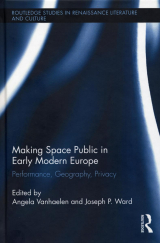
Making Space Public in Early Modern Europe: Performance, Geography, Privacy
Angela Vanhaelen and Joseph P. Ward, eds.
Vanhaelen, Angela, and Joseph P. Ward, eds. Making Space Public in Early Modern Europe: Performance, Geography, Privacy. New York: Routledge, 2013.
Broadening the conversation begun in Making Publics in Early Modern Europe (2009), this book examines how the spatial dynamics of public making changed the shape of early modern society. The publics visited in this volume are voluntary groupings of diverse individuals that could coalesce through the performative uptake of shared cultural forms and practices. The contributors argue that such forms of association were social productions of space as well as collective identities. Chapters explore a range of cultural activities such as theatre performances; travel and migration; practices of persuasion; the embodied experiences of lived space; and the central importance of media and material things in the creation of publics and the production of spaces. They assess a multiplicity of publics that produced and occupied a multiplicity of social spaces where collective identity and voice could be created, discovered, asserted, and exercised. Cultural producers and consumers thus challenged dominant ideas about just who could enter the public arena, greatly expanding both the real and imaginary spaces of public life to include hitherto excluded groups of private people. The consequences of this historical reconfiguration of public space remain relevant, especially for contemporary efforts to meaningfully include the views of ordinary people in public life.
 Inequity in the City: Race, Class, Gender, and the Digital Divide in Austin
Inequity in the City: Race, Class, Gender, and the Digital Divide in Austin
Joseph Straubhaar, Jeremiah Spence, Zeynep Tufekci, Roberta Lentz
Straubhaar, Joseph, Jeremiah Spence, Zeynep Tufekci and Rebecca G. Lentz. Inequity in the City: Race, Class, Gender, and the Digital Divide in Austin. University of Texas, 2012.
Over the past few decades, Austin, Texas, has made a concerted effort to develop into a “technopolis,” becoming home to companies such as Dell and numerous start-ups in the 1990s. It has been a model for other cities across the nation that wish to become high-tech centers while still retaining the livability to attract residents. Nevertheless, this expansion and boom left poorer residents behind, many of them African American or Latino, despite local and federal efforts to increase lower-income and minority access to technology. This book was born of a ten-year longitudinal study of the digital divide in Austin—a study that gradually evolved into a broader inquiry into Austin’s history as a segregated city, its turn toward becoming a technopolis, what the city and various groups did to address the digital divide, and how the most disadvantaged groups and individuals were affected by those programs. The editors examine the impact of national and statewide digital inclusion programs created in the 1990s, as well as what happened when those programs were gradually cut back by conservative administrations after 2000. They also examine how the city of Austin persisted in its own efforts for digital inclusion by working with its public libraries and a number of local nonprofits, and the positive impact those programs had.
![]() The Wake of Iconoclasm: Painting the Church in the Dutch Republic
The Wake of Iconoclasm: Painting the Church in the Dutch Republic
Angela Vanhaelen
Vanhaelen, Angela. The Wake of Iconoclasm: Painting the Church in the Dutch Republic. Penn State University Press, 2012.
In describing the seventeenth-century Dutch Republic, Johan Huizinga said, “Paintings could be found everywhere . . . everywhere except in churches.” Although pictures were ubiquitous in the Dutch world, the official religion expressed a fundamental distrust of visual imagery. Indeed, Calvinism and visual culture were both central modes of self-understanding in Dutch society. Investigating this paradox, The Wake of Iconoclasm takes as its main subject the numerous paintings of austere Calvinist church interiors that proliferated in the seventeenth century. Painstakingly crafted and highly naturalistic images of interiors, these peculiar paintings show spaces that were purged of visual imagery during and after the iconoclast riots of the sixteenth century. In essence, they depict the interface of the histories of art and religion. Angela Vanhaelen argues that the main function of this imagery was to stimulate debate about the transformed role of art in relation to the religious and political upheavals of the Reformation and the Dutch Revolt. Paintings of the emptied churches allowed their beholders to grapple with the significant public influence of Calvinism—especially its suppression of past cultural traditions and the new conditions of possibility it created for the visual arts.
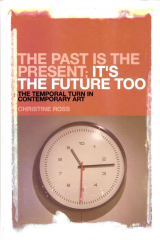 The Past is the Present, It's the Future Too: The Temporal Turn in Contemporary Art
The Past is the Present, It's the Future Too: The Temporal Turn in Contemporary Art
Christine Ross
Ross, Christine. The Past is the Present, It's the Future Too: The Temporal Turn in Contemporary Art. New York: Continuum, 2012
The term ‘temporality' often refers to the traditional mode of the way time is: a linear procession of past, present and future. As philosophers will note, this is not always the case. Christine Ross builds on current philosophical and theoretical examinations of time and applies them to the field of contemporary art: films, video installations, sculpture and performance works.
Ross first provides an interdisciplinary overview of contemporary studies on time, focusing on findings in philosophy, psychology, sociology, communications, history, postcolonial studies, and ecology. She then illustrates how contemporary artistic practices play around with what we consider linear time. Engaging the work of artists such as Guido van der Werve, Melik Ohanian, Harun Farocki, and Stan Douglas, allows investigation though the art, as opposed to having art taking an ancillary role. The Past is the Present; It's the Future Too forces the reader to understand the complexities of the significance of temporal development in new artistic practices.
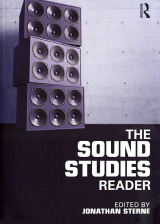 The Sound Studies Reader
The Sound Studies Reader
Jonathan Sterne
Sterne, Jonathan. The Sound Studies Reader. New York: Routledge, 2012.
The Sound Studies Reader blends recent work that self-consciously describes itself as ‘sound studies’ along with earlier and lesser-known scholarship on sound from across the humanities and social sciences. The Sound Studies Reader touches on key themes like noise and silence; architecture, acoustics and space; media and reproducibility; listening, voices and disability; culture, community, power and difference; and shifts in the form and meaning of sound across cultures, contexts and centuries. Writers reflect on crucial historical moments, difficult definitions, and competing accounts of the role of sound in culture and everyday life. Across the essays, readers will gain a sense of the range and history of key debates and discussions in sound studies.
The collection begins with an introduction to welcome novice readers to the field and acquaint them the main issues in sound studies. Individual section introductions give readers further background on the essays and an extensive up to date bibliography for further reading in sound studies make this an original and accessible guide to the field.
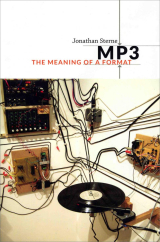 MP3: The Meaning of a Format
MP3: The Meaning of a Format
Jonathan Sterne
Sterne, Jonathan. MP3: The Meaning of a Format. Durham, NC: Duke University Press, 2012.
MP3: The Meaning of a Format recounts the hundred-year history of the world's most common format for recorded audio. Understanding the historical meaning of the MP3 format entails rethinking the place of digital technologies in the larger universe of twentieth-century communication history, from hearing research conducted by the telephone industry in the 1910s, through the mid-century development of perceptual coding (the technology underlying the MP3), to the format's promiscuous social life since the mid 1990s.
MP3s are products of compression, a process that removes sounds unlikely to be heard from recordings. Although media history is often characterized as a progression toward greater definition, fidelity, and truthfulness, MP3: The Meaning of a Format illuminates the crucial role of compression in the development of modern media and sound culture. Taking the history of compression as his point of departure, Jonathan Sterne investigates the relationships among sound, silence, sense, and noise; the commodity status of recorded sound and the economic role of piracy; and the importance of standards in the governance of our emerging media culture. He demonstrates that formats, standards, and infrastructures—and the need for content to fit inside them—are every bit as central to communication as the boxes we call "media."
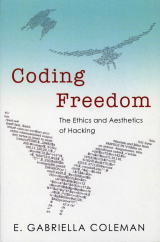 Coding Freedom: The Ethics and Aesthetics of Hacking
Coding Freedom: The Ethics and Aesthetics of Hacking
E. Gabriella Coleman
Coleman, E. Gabriella. Coding Freedom: The Ethics and Aesthetics of Hacking. Princeton University Press, 2012.
Who are computer hackers? What is free software? And what does the emergence of a community dedicated to the production of free and open source software--and to hacking as a technical, aesthetic, and moral project--reveal about the values of contemporary liberalism? Exploring the rise and political significance of the free and open source software (F/OSS) movement in the United States and Europe, Coding Freedom details the ethics behind hackers' devotion to F/OSS, the social codes that guide its production, and the political struggles through which hackers question the scope and direction of copyright and patent law. In telling the story of the F/OSS movement, the book unfolds a broader narrative involving computing, the politics of access, and intellectual property.
E. Gabriella Coleman tracks the ways in which hackers collaborate and examines passionate manifestos, hacker humor, free software project governance, and festive hacker conferences. Looking at the ways that hackers sustain their productive freedom, Coleman shows that these activists, driven by a commitment to their work, reformulate key ideals including free speech, transparency, and meritocracy, and refuse restrictive intellectual protections. Coleman demonstrates how hacking, so often marginalized or misunderstood, sheds light on the continuing relevance of liberalism in online collaboration.
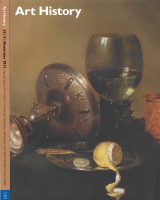 Art History - The Erotics of Looking: Materiality and Solicitation in Netherlandish Visual Culture
Art History - The Erotics of Looking: Materiality and Solicitation in Netherlandish Visual Culture
Angela Vanhaelen and Bronwen Wilson
Vanhaelen, Angela and Wilson, Bronwen (Eds). Art History Special Issue: The Erotics of Looking: Materiality and Solicitation in Netherlandish Visual Culture. (Vol. 35, no.5, 2012).
From the slyly suggestive to the overtly erotic, many early modern Dutch and Flemish artworks were designed to attract the eye, and yet the messages they convey are often equivocal. The Erotics of Looking: Early Modern Netherlandish Art presents a collection of provocative essays by leading scholars of art that delve into ways that material and pictorial qualities of descriptive artworks appeal to beholders to become involved with them. Exploring complex interrelations between making, displaying, and engaging with paintings and prints, the volume brings forward mechanisms through which visual imagery fostered new forms of association in early modern Europe. An introductory chapter lays out the innovative theoretical framework, arguing that descriptive pictures operated as social things, encouraging people to engage with them through the pleasures they offered the senses, prompting debate and potentially opening up ethical and political considerations about the interconnectedness of pictures and the material world. Challenging familiar interpretive models of iconography, verisimilitude, and social art history, the essays shift the focus away from a picture’s meaning toward why art matters, toward how artworks solicit beholders and stimulate deliberation. The Erotics of Looking: Early Modern Netherlandish Art not only offers illuminating insights into ways to look at art - it redefines the concept of art itself.
 Transnational Yearnings: Tourism, Migration, and the Diagonic City
Transnational Yearnings: Tourism, Migration, and the Diagonic City
Jenny Burman
Burman, Jenny. Transnational Yearnings: Tourism, Migration, and the Diagonic City. Vancouver: University of BC Press, 2011.
The global pathways that connect cities and nations are congested with people, money, and cultural transmissions. These routes are also hampered by uneven power relations and the efforts of groups to maintain or change them. How do hopes and dreams, feelings of guilt or loss affect transnational migration and the way migrants relate to their environment and to one another?
This book is about the migrations and uneven exchanges that bind postcolonial Jamaica to the diasporic city. It is about the desires, intimacies, and power relations that at once inform and reflect transnational migration and the diasporization of urban space. Transnational Yearnings maps a new way to look at contemporary contact zones and global interconnections as it traces circuits of migration and leisure travel between the Caribbean and Toronto, a city that has become for Jamaican Canadians both a place of promise and cultural vitality and a site of criminalization and exclusion through deportation.
Transnational Yearnings is an important addition to recent scholarship on Caribbean transnationalism and Canadian-Caribbean relations. By merging the study of large-scale processes, local opposition movements, and interpersonal connections, it paints a fuller portrait than Jamaican immigrants often receive in the media and will appeal to anyone interested in tourism, migration, postcolonialism, and global exchange.
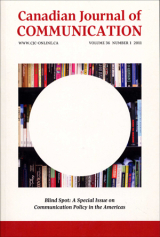 Canadian Journal of Communication Special Issue - Democratizing Communication Policy in the Americas: Why It Matters
Canadian Journal of Communication Special Issue - Democratizing Communication Policy in the Americas: Why It Matters
Becky Lentz and Leslie Regan Shade
Lentz, Roberta, & Leslie Regan Shade. "Democratizing Communication Policy in the Americas: Why It Matters." Canadian Journal of Communication [Online], 36.1 (2011): n. pag. Web. 26 Mar. 2015
The special issue is edited by Dr. Becky Lentz of McGill University's Department of Art History and Communication Studies Department and Dr. Leslie Regan Shade of Concordia University's Department of Communication. This special issue of the CJC seeks to address how communication policies affect economic, social justice and human rights concerns, and features an array of articles and reviews about how policy researchers and civil society organizations in various parts of the Americas are working together to develop communication policies and programs.
 Intersections of Media and Communications: Concepts and Critical Framework
Intersections of Media and Communications: Concepts and Critical Framework
Will Straw, Sandra Gabriele, Ira Wagman
Straw, Will, Sandra Gabriele, and Ira Wagman. Intersections of Media and Communications: Concepts and Critical Framework. Toronto: Emond Montgomery Publications, 2011.
Emphasizing fundamental concepts and key questions, and giving close consideration to how today's students experience media, this brand new introductory text for courses in media and communications studies and sociology of media offers a fresh approach to the topic.
The concise, focused chapters have been contributed by respected scholars from across Canada, resulting in an engaging and thorough exploration of this increasingly prominent aspect of modern life. Examples are drawn from Canada and beyond, with attention paid throughout to both current developments and historical perspectives.
Intersections explores how media affect our relationships to everything — they don't just inform and entertain us, but shape our connections to the world, and define our relationships to it.
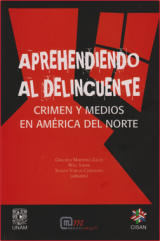
Aprehendiendo al delincuente: Crimen y mediios en América del norte
Will Straw, Graciela Martinez-Zalce, Will Straw and Susana Vargas (Eds.)
Martinez-Zalce, Graciela, Will Straw and Susana Vargas. Aprehendiendo al delincuente: Crimen y mediios en América del norte. Mexico City: CISAN/UNAM and Media@McGill, 2011.
For almost twenty years, researchers from the Centre for Research on North America (CISAN) at the National Autonomous University of Mexico (UNAM) have worked in close collaboration with scholars in the Department of Art History and Communications Studies (and one of its predecessor units, the Graduate Program in Communications) at McGill University. With this book, Media@McGill is happy to support the latest outcome of this collaboration. Co-published by Media@McGill and CISAN, and published in both hard copy and electronic form, Aprehendiendo al delincuente: Crimen y medios en América del norte, is edited by Dr. Graciela Martinez-Zalce (CISAN), Dr. Will Straw and Susana Vargas Cervantes (McGill).
In 2007, a Media@McGill conference on “Crime, Media and Culture” brought together scholars from across North America to address the relationship of media and crime. A subsequent conference at UNAM in Mexico City, on “Crimen, sociedad y medios in Norteamérica,” in 2010, forms the basis for this book. Various aspects of the interplay between crime and media are addressed here, from representations of sexuality in the Mexican tabloid press through the manner in which Canadian television programs portray threats to national security from countries to the south.
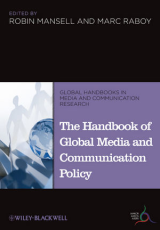
The Handbook of Global Media and Communication Policy
Marc Raboy and Robin Mansell, eds.
Raboy, Marc and Robin Mansell (eds.) The Handbook of Global Media and Communication Policy Malden, MA: Wiley-Blackwell, 2011.
The Handbook of Global Media and Communication Policy offers insights into the boundaries of this field of study, assesses why it is important, who is affected, and with what political, economic, social and cultural consequences.
- Provides the most up to date and comprehensive collection of essays from top scholars in the field
- Includes contributions from western and eastern Europe, North and Central America, Africa and Asia
- Offers new conceptual frameworks and new methodologies for mapping the contours of emergent global media and communication policy
- Draws on theory and empirical research to offer multiple perspectives on the local, national, regional and global forums in which policy debate occurs
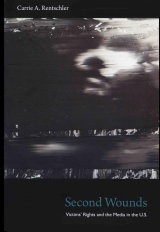 Second Wounds: Victims' Rights and the Media in the U.S.
Second Wounds: Victims' Rights and the Media in the U.S.
Carrie Rentschler
Rentschler, Carrie. Second Wounds: Victims' Rights and the Media in the U.S. Durham, NC: Duke Press, 2011.
The U.S. victims’ rights movement has transformed the way that violent crime is understood and represented in the United States. It has expanded the concept of victimhood to include family members and others close to direct victims, and it has argued that these secondary victims may be further traumatized through their encounters with insensitive journalists and the cold, impersonal nature of the criminal justice system. This concept of extended victimization has come to dominate representations of crime and the American criminal justice system. In Second Wounds, Carrie A. Rentschler examines how the victims’ rights movement brought about such a marked shift in how Americans define and portray crime. Analyzing the movement’s effective mobilization of activist networks and its implementation of media strategies, she interprets texts such as press kits, online victim memorials, and training materials for victims’ advocates and journalists. Rentschler also provides a genealogy of the victims’ rights movement from its emergence in the 1960s into the twenty-first century. She explains that while a “get tough on crime” outlook dominates the movement, the concept of secondary victimization has been invoked by activists across the political spectrum, including anti–death penalty advocates, who contend that the families of death-row inmates are also secondary victims of violent crime and the criminal justice system.
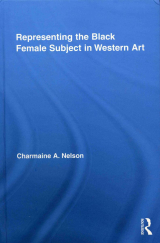 Representing the Black Female Subject in Western Art
Representing the Black Female Subject in Western Art
Charmaine Nelson
Nelson, Charmaine. Representing the Black Female Subject in Western Art. New York: Routledge, 2010.
This book offers the first concentrated examination of the representation of the black female subject in Western art through the lenses of race/color and sex/gender. Charmaine A. Nelson poses critical questions about the contexts of production, the problems of representation, the pathways of circulation and the consequences of consumption. She analyzes not only how, where, why and by whom black female subjects have been represented, but also what the social and cultural impacts of the colonial legacy of racialized western representation have been. Nelson also explores and problematizes the issue of the historically privileged white artistic access to black female bodies and the limits of representation for these subjects. This book not only reshapes our understanding of the black female representation in Western Art, but also furthers our knowledge about race and how and why it is (re)defined and (re)mobilized at specific times and places throughout history.
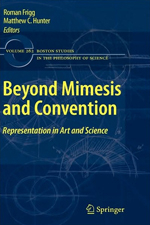 Beyond Mimesis and Convention: Representation in Art and Science
Beyond Mimesis and Convention: Representation in Art and Science
Matthew Hunter and Roman Frigg
Hunter, Matthew and Roman Frigg. Beyond Mimesis and Convention: Representation in Art and Science. New York: Springer, 2010.
"Beyond Mimesis and Convention: Representation in Art and Science" is motivated by the conviction that we students of the sciences and arts are best served by confronting our mutual impasse and by recognizing the shared concerns that have necessitated our covert acts of kleptomania. Drawing leading contributors from the philosophy of science, the philosophy of literature, art history and visual studies, our volume takes its brief from our title. That is, these essays aim to put the evidence of science and of art to work in thinking about representation by offering third (or fourth, or fifth) ways beyond mimesis and convention. In so doing, our contributors explore a range of topics-fictionalism, exemplification, neuroaesthetics, approximate truth-that build upon and depart from ongoing conversations in philosophy of science and studies of visual art in ways that will be of interest to both interpretive communities. To put these contributions into context, the remainder of this introduction aims to survey how our communities have discretely arrived at a place wherein the perhaps-surprising collaboration between philosophy of science and art history has become not only salubrious, but a matter of necessity.
 Circulation and the City: Essays on Urban Culture
Circulation and the City: Essays on Urban Culture
Will Straw and Alexandra Boutros, eds.
Straw, Will, and Alexandra Boutros, eds. Circulation and the City: Essays on Urban Culture. Toronto: McGilligan, 2010.
The lived experience of cities has long been defined by motion. As urban dwellers travel to work, home and play they carve random or predictable pathways across neighbourhoods and districts. Circulation And The City investigates the urban capacity for movement, The city as a space of circulation, by taking into account not only the physical displacement of people, but the circulation of cultures, things, and ideas. A series of rich case studies examine a range of topics including neighbourhood gentrification, subway busking, yard sales, electronic waste and language, refining the touchstone principle of circulation For The study of urban culture, both materially and theoretically. Contributors employ a variety of disciplinary approaches to create a richly varied picture of the multiple trajectories and effects of movement in the city. An engaging work that considers city planning, urban culture, and social behaviour,Circulation And The City adds a new dimension that revitalises the ways we have commonly looked at – and thought about – the city.
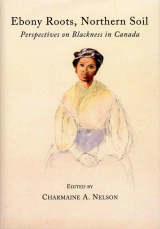 Ebony Roots, Northern Soil: Perspectives on Blackness in Canada
Ebony Roots, Northern Soil: Perspectives on Blackness in Canada
Charmaine Nelson
Nelson, Charmaine, ed. Ebony Roots, Northern Soil: Perspectives on Blackness in Canada. Cambridge Scholars Publishing, 2010.
"Ebony Roots, Northern Soil" is a powerful and timely collection of critical essays exploring the experiences, histories and cultural engagements of black Canadians. Drawing from postcolonial, critical race and black feminist theory, this innovative anthology brings together an extraordinary set of well-recognized and new scholars engaging in the critical debates about the cultural politics of identity and issues of cultural access, representation, production and reception. Emerging from a national conference in 2005, the book records, critiques and yet transcends this groundbreaking event. Drawn from a range of disciplines including Art History, Communication Studies, Cultural Studies, Education, English, History and Sociology, the chapters examine black contributions to and participation within the realms of popular music, television and film, the art world, museums, academia and social activism. In the process, the burning issues of access to cultural capital, the practice of multiculturalism, definitions of black Canadianness and the state of Black Canadian Studies are dissected. Attentive to issues of sexuality and gender as well as race, the book also explores and challenges the dominance of black Americanness in Canada, especially in its incarnation as hip hop. Acknowledging a differently constituted and heterogeneous black Canadianness, it contemplates the possibility of an identity in dialogue with, and yet distinct from, dominant ideals of African-Americanness. "Ebony Roots" also explores the deficit in Black Canadian Studies across the nation's universities, drawing a line between the neglect of black Canadian populations, histories and experiences in general and the resulting lack of an academic disciplinary infrastructure. Poignant blends of the personal and the political, the chapters are both scholarly in their critical insights and rigour and daring in their honesty. "Ebony Roots" defiantly foregrounds the often-disavowed issues of institutional racism against blacks in Canadian academia, education and cultural institutions as well as the injurious effects of everyday racism. In so doing, the book challenges the myth of Canada as a racially benevolent and tolerant state, the 'great white north' free from racism and the legacy of colonialism. Instead the very definitions of Canada and black Canadianness are unpacked and explored. "Ebony Roots" is a necessary history lesson, a contemporary cultural debate and a call to action. It is a momentous and overdue contribution to Black Canadian Studies and a must read for academics, students and the general public alike.
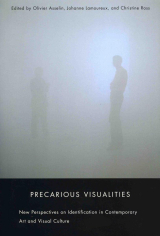 Precarious Visualities: New Perspectives on Identification in Contemporary Art and Visual Culture
Precarious Visualities: New Perspectives on Identification in Contemporary Art and Visual Culture
Olivier Asselin, Johanne Lamoureux, Christine Ross, eds.
Asselin, Olivier, Johanne Lamoureux, and Christine Ross, eds. Precarious Visualities: New Perspectives on Identification in Contemporary Art and Visual Culture. McGill-Queens University Press, 2008.
Bringing together international scholars from various disciplines, "Precarious Visualities" examines the transformation of our relation to images in contemporary visual culture. Through the study of exemplary media arts works and practices - photography, film, video, performance, installations, webcams, etc - these essays call attention to the precarious attachments of contemporary spectatorship. To look at an image that prevents the stabilization of identification, identity and place; to perceive a representation that keeps oscillating between visibility and invisibility; to be interpellated by screen-images that have ceased to mirror, resemble or refer in that their power lies exclusively on their simulating, hallucinating, blinding or generating function; to relate to an image which entails a rebalancing of sight through the valorization of other senses; to be exposed - through surveillance devices - to the gaze of new figures of authority, unanticipated. Others: the aesthetic experiences examined here concern a spectator whose perception lacks in certainty, identification and opticality what it gains in fallibility, complexity and interrelatedness. Attentive to these precarious attachments, "Precarious Visualities" provides a new understanding of spectatorship, as a relation that is at once corporeal and imaginary, yet persistently prolific in its cultural, social and political effects.
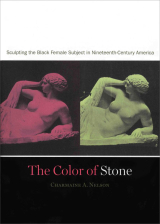 The Color of Stone: Sculpting the Black Female Subject in Nineteenth-Century America
The Color of Stone: Sculpting the Black Female Subject in Nineteenth-Century America
Charmaine Nelson
Nelson, Charmaine. The Color of Stone: Sculpting the Black Female Subject in Nineteenth-Century America. Minneapolis: University of Minnesota Press, 2007.
How do we "see" race when the color of skin is stone. Nineteenth-century neoclassical sculpture was a highly politicized international movement. Based in Rome, many expatriate American sculptors created works that represented black female subjects in compelling and problematic ways. Rejecting pigment as dangerous and sensual, adherence to white marble abandoned the racialization of the black body by skin color.
In The Color of Stone, Charmaine A. Nelson brilliantly analyzes a key, but often neglected, aspect of neoclassical sculpture—color. Considering three major works—Hiram Powers's Greek Slave, William Wetmore Story's Cleopatra, and Edmonia Lewis's Death of Cleopatra—she explores the intersection of race, sex, and class to reveal the meanings each work holds in terms of colonial histories of visual representation as well as issues of artistic production, identity, and subjectivity. She also juxtaposes these sculptures with other types of art to scrutinize prevalent racial discourses and to examine how the black female subject was made visible in high art.
By establishing the centrality of race within the discussion of neoclassical sculpture, Nelson provides a model for a black feminist art history that at once questions and destabilizes canonical texts.
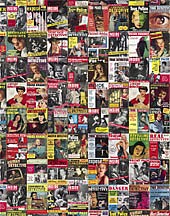
Cyanide and Sin. Visualizing Crime in 50's America
Will Straw
Straw, Will. Cyanide and Sin. Visualizing Crime in 50's America. PPP Editions, New York, 2006. 192 pp., 196 four-color illustrations, 9x12".
Cyanide and Sin offers a broad history of the true crime magazine in America with an emphasis on the 1950s and on the visual content of these magazines. Will Straw, a scholar in the Department of Art History and Communications Studies at McGill University in Montreal, Canada, has written a 12,000 word essay that traces the stylistic and conceptual evolution of the Crime magazine genre. He catalogues specific photographers and key designers who were regular contributors to the various magazines. The book contains 196 images from the true crime genre.
Many of the images reproduced both within these magazines and on their covers were set- up reenactments of crimes, some fictive, others real. Often, the images are accompanied by lurid titles such as: Death Crashes A Party, Love Me or Die!, He Was Too Hot To Cool Down.
There have been numerous publications on the history of pulp and crime fiction. Cyanide and Sin is the first book to look at the true crime magazine and the visuals which were a significant part of its appeal. As Straw writes:
'Crime lent itself readily to some of the most powerful impulses within modern image-making. It gave photographers drawn to social marginality subjects with which to avoid the sentimentality that too easily clings to images of the poor or downtrodden. Crime photography has served as the basis for transgressive violations of good taste, and for romantic glorifications of the doomed life. The images assembled in true crime magazines over their 80 year history have moved ceaselessly between what photographic historian Allan Sekula calls the honorific and repressive functions of photography. Images celebrating an extravagant individuality, for instance, have sat alongside others calling for citizen complicity in the enforcement of state power. '
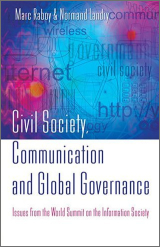 Civil Society, Communication and Global Governance: Issues from the World Summit on the Information Society
Civil Society, Communication and Global Governance: Issues from the World Summit on the Information Society
Marc Raboy and Normand Landry
Raboy, Marc and Landry, Normand. Civil Society, Communication and Global Governance: Issues from the World Summit on the Information Society. New York: Peter Lang Academic Publishing, 2005.
In 2003 and again in 2005, the international community was called to take part in a World Summit on the Information Society (WSIS). This two-phase United Nations summit placed an unprecedented global spotlight on information and communication issues. Civil Society, Communication and Global Governance provides a sweeping portrait of the players, structures and themes of the WSIS, as well as a critical analysis of the summit's first phase, the issues it raised and the groundbreaking role played by civil society. Including an extensive bibliography, list of relevant web sites and key documents, this will be a basic reference source for everyone interested in the role of information and communication on shaping twenty-first-century societies.

Communication Technology: The Canadian Democratic Audit
Darin Barney
Barney, Darin. Communication Technology: The Canadian Democratic Audit. Vancouver: University of British Columbia Press, 2005.
When the Internet began to emerge as a popular new mode of communication, many political scientists and social commentators believed that it would revolutionize our democratic institutions. Today, voter turnout is at an historic low and Internet usage is at an all-time high. Can we still make the claim that new information and communication technologies (ICTs) enhance democratic life in Canada? What effect does the technological mediation of political communication have on the practice of Canadian politics? How have such technologies affected the distribution of power in society?
Darin Barney investigates the links between ICTs and democratic processes, arguing that the potential of digital technologies to contribute to a more democratic political system will remain largely untapped unless the more conventional dimensions of Canadian politics, the economy, and modes of governance are reoriented.
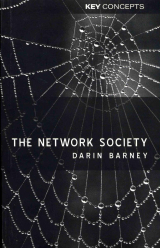 The Network Society
The Network Society
Darin Barney
Barney, Darin. The Network Society. Cambridge, U.K.: Polity Press, 2005.
In The Network Society, Darin Barney provides a compelling examination of the social, political and economic implications of network technologies and their application across a wide range of practices and institutions.
Are we in the midst of a digital revolution? Have new information and communication technologies given birth to a new form of society, or do they reinforce and extend existing patterns and relationships? This book provides a clear and engaging discussion of these and other questions. Using a sophisticated model of the relationship between technology and society, Barney investigates both what has changed, and what has remained the same, in the age of the Internet. Among the issues discussed are debates concerning the emergence of a "knowledge economy"; digital restructuring of employment and work; globalization and the status of the nation-state; the prospects of digital democracy; the digital divide; new social movements; and culture, community and identity in the age of new media.
This book provides an accessible resource for a thoughtful engagement with life in the network society. It will be essential reading for students in sociology and media and communications studies. This will be a valuable textbook for undergraduate students of sociology and media and communications studies.
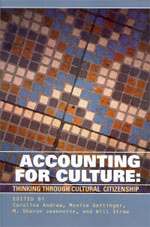
Accounting for Culture: Thinking Through Cultural Citizenship
Will Straw, Caroline Andrew, Monica Gattinger, and Sharon Jeannotte, eds.
Straw, Will and Andrew, Caroline, Gattinger, Monica and Jeannotte, Sharon, eds. Accounting for Culture: Thinking Through Cultural Citizenship. Ottawa: The University of Ottawa Press, 2005.
Many scholars, practitioners, and policy-makers in the cultural sector argue that Canadian cultural policy is at a crossroads: that the environment for cultural policy-making has evolved substantially and that traditional rationales for state intervention no longer apply.
The concept of cultural citizenship is a relative newcomer to the cultural policy landscape, and offers a potentially compelling alternative rationale for government intervention in the cultural sector. Likewise, the articulation and use of cultural indicators and of governance concepts are also new arrivals, emerging as potentially powerful tools for policy and program development.
Accounting for Culture is a unique collection f essays from leading Canadian and international scholars that critically examines cultural citizenship, cultural indicators, and governance in the context of evolving cultural practices and cultural policy-making. It will be of strong interest to scholars of cultural policy, communications, cultural studies, and public administration alike.

The Aesthetics of Disengagement: Contemporary Art and Depression
Christine Ross
Ross, Christine. The Aesthetics of Disengagement: Contemporary Art and Depression. Minneapolis: University of Minnesota Press, 2005.
Reveals how artists engage the scientific notion of depression.
According to the National Institute of Mental Health, more than half of the world's population will have a depressive disorder at some point in their lifetimes. In The Aesthetics of Disengagement Christine Ross shows how contemporary art is a powerful yet largely unacknowledged player in the articulation of depression in Western culture, both adopting and challenging scientific definitions of the condition. Ross explores the ways in which contemporary art performs the detached aesthetics of depression, exposing the viewer's loss of connection and ultimately redefining the function of the image.
Ross examines the works of Ugo Rondinone, Rosemarie Trockel, Ken Lum, John Pilson, Liza May Post, Vanessa Beecroft, and Douglas Gordon, articulating how their art conveys depression's subjectivity and addresses a depressed spectator whose memory and perceptual faculties are impaired. Drawing from the fields of psychoanalysis as well as psychiatry, Ross demonstrates the ways in which a body of art appropriates a symptomatic language of depression to enact disengagement—marked by withdrawal, radical protection of the self from the other, distancing signals, isolation, communication ruptures, and perceptual insufficiency.
Most important, Ross reveals the ways in which art transforms disengagement into a visual strategy of disclosure, a means of reaching the viewer, and how in this way contemporary art puts forth a new understanding of depression.
In 2003 and again in 2005, the international community was called to take part in a World Summit on the Information Society (WSIS). This two-phase United Nations summit placed an unprecedented global spotlight on information and communication issues. Civil Society, Communication and Global Governance provides a sweeping portrait of the players, structures and themes of the WSIS, as well as a critical analysis of the summit's first phase, the issues it raised and the groundbreaking role played by civil society. Including an extensive bibliography, list of relevant web sites and key documents, this will be a basic reference source for everyone interested in the role of information and communication on shaping twenty-first-century societies.

Racism,Eh?: A Critical Inter-Disciplinary Anthology of Race in the Canadian Context
Charmaine Nelson
Nelson, Charmaine, ed. Racism, Eh?: A Critical Inter-Disciplinary Anthology of Race in the Canadian Context. Concord, Ontario: Captus Press/Captus University Publications, 2004.
Racism, Eh? Is the first publication that examines racism within the broad Canadian context. It focuses fundamentally on two key aspects of identity or identification – race and nationality – and the complex ways in which they intersect.
Inter-disciplinary in nature, this anthology brings together many of the visionaries seeking to illuminate the topics of race and racism in Canada. Through their analyses of historical and contemporary issues, race and racism are addressed as both physical and psychological phenomena.
This book is ideal for undergraduate and graduate students, as well as academics who are studying or practicing within Humanities and the Social Sciences. Anyone searching for information on what has been a little-explored and poorly-understood Canadian issue will also find Racism Eh? An invaluable resource.
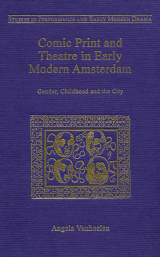 Comic Print and Theatre in Early Modern Amsterdam: Gender, Childhood and the City
Comic Print and Theatre in Early Modern Amsterdam: Gender, Childhood and the City
Angela Vanhaelen
Vanhaelen, Angela. Comic Print and Theatre in Early Modern Amsterdam: Gender, Childhood and the City. Farnham: Ashgate Pub, 2003.
Late-17th-century Amsterdam saw the emergence of a range of printed pictures marketed specifically for children. Like the farcical plays from the city's theatre tradition, these prints-picturing scenes of violence, lust, trickery, and madness in the city's homes, markets, streets and waterways-turn Amsterdam's most cherished social and symbolic spaces upside-down. The material seems completely antagonistic to contemporary convictions that the upbringing of children was crucial to securing the future of the household, the city, and the Dutch Republic. Angela Vanhaelen here poses the question of why such sex-tinged, slap-stick images were directed at Protestant children. Working from this paradox, this interdisciplinary study examines the complicated relations between print and technology, the practices of theatre, and the process of urban identity formation. Traditional comic forms were appropriated by both producers and consumers who had much at stake in religious and political battles over the control of Amsterdam and its populations. Analyzing the role of farcical theatre within these power struggles, Vanhaelen demonstrates how concerns about the city's future were deflected onto children. In the first chapter, Vanhaelen examines anxieties about the educational uses of comic material in the schoolroom, the theatre and the home. In the next two chapters, she considers the ways that this material both defined and disrupted the gendered process of initiating children into Amsterdam's most vital public and private spaces: the market and the home. The book concludes with a broader analysis of how the bodies of women and children were connected to shifting definitions of the city.
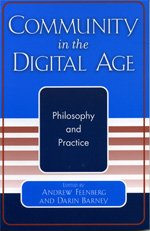 Community in the Digital Age: Philosophy and Practice
Community in the Digital Age: Philosophy and Practice
Darin Barney and Andrew Feenberg, eds.
Barney, Darin and Feenberg, Andrew, eds. Community in the Digital Age: Philosophy and Practice. (Lanham, MD: Rowman and Littlefield, 2004).
Is the Internet the key to a reinvigorated public life? Or will it fragment society by enabling citizens to associate only with like-minded others? Online community has provided social researchers with insights into our evolving social life. As suburbanization and the breakdown of the extended family and neighborhood isolate individuals more and more, the Internet appears as a possible source for reconnection. Are virtual communities "real" enough to support the kind of personal commitment and growth we associate with community life, or are they fragile and ultimately unsatisfying substitutes for human interaction? Community in the Digital Age features the latest, most challenging work in an important and fast-changing field, providing a forum for some of the leading North American social scientists and philosophers concerned with the social and political implications of this new technology. Their provocative arguments touch on all sides of the debate surrounding the Internet, community, and democracy.
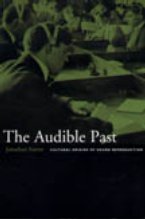
The Audible Past: Cultural Origins of Sound Reproduction
Jonathan Sterne
Sterne, Jonathan. The Audible Past: Cultural Origins of Sound Reproduction. Durham: Duke University Press, 2003.
The Audible Past explores the cultural origins of sound reproduction. It describes a distinctive sound culture that gave birth to the sound recording and the transmission devices so ubiquitous in modern life. With an ear for the unexpected, scholar and musician Jonathan Sterne uses the technological and cultural precursors of telephony, phonography, and radio as an entry point into a history of sound in its own right. Sterne studies the constantly shifting boundary between phenomena organized as "sound" and "not sound." In The Audible Past, this history crisscrosses the liminal regions between bodies and machines, originals and copies, nature and culture, and life and death.
Blending cultural studies and the history of communication technology, Sterne follows modern sound technologies back through a historical labyrinth. Along the way, he encounters capitalists and inventors, musicians and philosophers, embalmers and grave robbers, doctors and patients, deaf children and their teachers, professionals and hobbyists, folklorists and tribal singers. The Audible Past tracks the connections between the history of sound and the defining features of modernity: from developments in medicine, physics, and philosophy to the tumultuous shifts of industrial capitalism, colonialism, urbanization, modern technology, and the rise of a new middle class.
A provocative history of sound, The Audible Past challenges theoretical commonplaces such as the philosophical privilege of the speaking subject, the visual bias in theories of modernity, and static descriptions of nature. It will interest those in cultural studies, media and communication studies, the new musicology, and the history of technology.
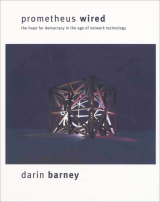 Prometheus Wired: The Hope for Democracy in the Age of Network Technology
Prometheus Wired: The Hope for Democracy in the Age of Network Technology
Darin Barney
Barney, Darin. Prometheus Wired: The Hope for Democracy in the Age of Network Technology. University Of Chicago Press, 2001.
From all sides, we hear that computer technology, with its undeniable power to disseminate information and connect individuals, holds enormous potential for a reinvigoration of political life. But will the Internet really spark a democratic revolution? And will the changes it brings be so profound that past political thought will be of little use in helping us to understand them?
In Prometheus Wired, Darin Barney debunks claims that a networked society will provide the infrastructure for a political revolution and shows that the resources we need for understanding and making sound judgements about this new technology are surprisingly close at hand. By looking to thinkers who grappled with the relationship of society and technology, such as Plato, Aristotle, Marx, and Heidegger, Barney critically examines such assertions about the character of digital networks.
Along the way, Barney offers an eye-opening history of digital networks and then explores a wide range of contemporary issues, such as electronic commerce, telecommuting, privacy, virtual community, digital surveillance, and the possibility of sovereign governance in an age of global networks. Ultimately, Barney argues that instead of placing power back in the hands of the public, a networked economy seems to exacerbate the worst features of industrial capitalism, and, in terms of the surveillance and control it exerts, reduces our political freedom.
Of vital interest to politicians, communicators, and anyone concerned about the future of democracy in the digital age, Prometheus Wired adds a provocative new voice to the debate swirling around "the Net" and the ways in which it will, or will not, change our political lives.
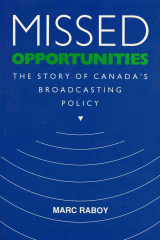 Missed Opportunities: The Story of Canada's Broadcasting Policy
Missed Opportunities: The Story of Canada's Broadcasting Policy
Marc Raboy
Raboy, Marc. Missed Opportunities: The Story of Canada's Broadcasting Policy. McGill-Queen's Press, 1990.
Toward the end of his career, Graham Spry used the phrase "missed opportunities" in reference to Canadian broadcasting. Raboy shows which opportunities have been missed and clarifies the relationship between the evolution of Canadian broadcasting policy over the past sixty years and the changes in Canadian society during the same period.
 Movements and Messages: Media and Radical Politics in Quebec
Movements and Messages: Media and Radical Politics in Quebec
Marc Raboy
Raboy, Marc. Movements and Messages: Media and Radical Politics in Quebec. Toronto: Between the Lines, 1984.
Movements and Messages is a rare study of an important political phenomenon – the attempt by social and political movements to shape their own communication strategies in opposition to the power of the State and mainstream media.
Marc Raboy digs into the turbulent Quebec of the sixties and seventies and comes up with a wealth of communications initiatives – from the alternative newsweekly Québec-Presse and the news agency l’Agence de presse libre du Québec to the daily Le Jour , the short-lived attempt of the Parti québécois to exert its own control over news. He analyzes the “direct communication” tactics of the 1970 October Crisis and the 1972 general strike in the public sector and the emergence in the 1970s of the Marxist-Leninist movement with its publications Mobilisation and Bulletin populaire.
These media initiatives contributed to the building of a new culture in Quebec, one that still exists today. But at the same time, Raboy finds, social movements operating in the heat of battle used de facto communication strategies. They provided only partial answers to the problems of communications, or sometimes only reproduced the patterns of domination being opposed.
Movements and Messages appears at a time when people in Quebec and elsewhere are beginning to ask new questions about the diverse forms of militant action. Marc Raboy’s research and conclusions are pertinent to anyone interested in the frustrating - but crucial- link between media and social and political change.